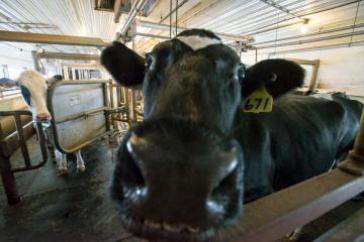UNH Research: Lactation, Weather Found to Predict Milk Quality in Dairy Cows

This cow just finished being milked at the UNH Fairchild Dairy Teaching and Research Center, one of the sites of the research study.
DURHAM, N.H. - The quality of colostrum - the nutrient-rich milk newborn dairy calves first drink from their mothers - can be predicted by the mother's previous lactation performance and weather, according to new research from the NH Agricultural Experiment Station at the University of New Hampshire.
UNH researchers found that previous lactation performance data can predict colostrum quality; the more lactations the cow has had in the past, the higher the quality of colostrum in the future. This method allows dairy producers to predict colostrum quality before the calf is born and the ability to estimate Immunoglobulin G content, which is the primary measure of colostrum quality, of the colostrum without having to collect it.
Colostrum is a concentrated source of nutrients, which includes fats, proteins, including immunoglobulins such as Immunoglobulin G (IgG), carbohydrates, vitamins, and minerals. It is key in supporting the health of the young dairy animal. Previous research has found that inadequate feeding of quality colostrum to newborn calves can result in reduced growth rates, increased risk of disease and death, increased risk of being culled, and decreased milk production in the first and second lactations.
The research was conducted by UNH doctoral graduate Rosemarie Cabral; UNH doctoral students Colleen Chapman and Kayla Aragona; former UNH undergraduate student Elizabeth Clark; Michal Lunak, extension assistant professor and dairy specialist; and Peter Erickson, professor of biological sciences and extension dairy specialist. The research is presented in the forthcoming issue of the Journal of Dairy Science.
"The long-term effects of colostrum determine the success of the cow, and therefore special care should be taken to ensure colostrum of the highest quality is provided to the newborn calf," Erickson said.
Currently, dairy farmers can test colostrum using two tools: a colostrometer or refractometer. While these methods are effective in estimating IgG concentration, many dairy producers do not have access to these tools or do not take the time to test their colostrum prior to feeding. According to the USDA, only 5.7 percent of U.S. dairy producers evaluated colostrum quality using a colostrometer.
Researchers also found that the poorest quality colostrum was produced during the winter. The researchers theorize that in warmer temperatures, the blood vessels of the cow dilate, causing them to be more permeable to IgG. This increased permeability of the blood vessels may lead to improved colostrum.
"It is apparent from these studies that environmental temperature or day length has an impact on colostrum quality," the researchers said.
There are approximately 130 dairy farms in New Hampshire with an average of 115 milking animals per farm. The New Hampshire dairy industry impacts state and local economies with more than $141 million in total output, more than 3,700 jobs and more than $19 million in labor income, according to Granite State Dairy Promotion.
The following New Hampshire farms participated in this study: Bodwell Dairy, Bohannon Farm, Briarstone Farm, Highway View Dairy, Fernald Farm, Fitch Farm, Grafton County Farm, Houston's Pine Lane Farm, Jones Dairy Farm, Morrill Farm Dairy, Naughtaveel Farm, Perkins Dairy, Pomeroy Dairy, Stuart Farm, Tullando Farm, UNH Fairchild Dairy Teaching and Research Center, Wyndyhurst Holsteins, and Yeaton Farm.
This material is based upon work supported by the NH Agricultural Experiment Station, through joint funding of the National Institute of Food and Agriculture, U.S. Department of Agriculture, under award number 1001283, and the state of New Hampshire. This study also was supported in part by the George Walker Research Fund.
Founded in 1887, the NH Agricultural Experiment Station at the UNH College of Life Sciences and Agriculture is UNH's original research center and an elemental component of New Hampshire's land-grant university heritage and mission. We steward federal and state funding, including support from the USDA National Institute of Food and Agriculture, to provide unbiased and objective research concerning diverse aspects of sustainable agriculture and foods, aquaculture, forest management, and related wildlife, natural resources and rural community topics.
The University of New Hampshire, founded in 1866, is a world-class public research university with the feel of a New England liberal arts college. A land, sea, and space-grant university, UNH is the state's flagship public institution, enrolling 13,000 undergraduate and 2,500 graduate students.
PHOTO
https://colsa.unh.edu/nhaes/sites/colsa.unh.edu.nhaes/files/media/images/fairchildcow300.jpg
Caption: This cow just finished being milked at the UNH Fairchild Dairy Teaching and Research Center, one of the sites of the research study.
Latest News
-
October 30, 2024
-
October 10, 2024
-
October 8, 2024
-
October 3, 2024
-
October 1, 2024
















































